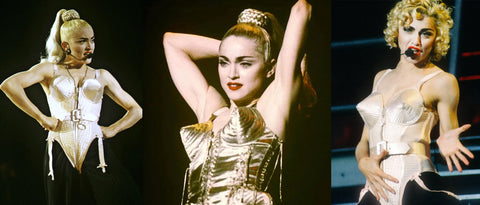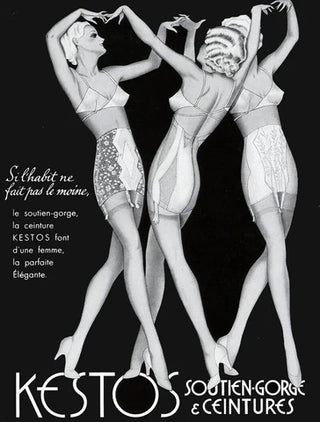Lingerie and shapewear have long been an integral part of a woman's wardrobe, serving as the foundation upon which her outer garments are built. The term "foundation garments" was coined precisely to describe the pieces that would provide this essential support for a woman's clothing. Dating back centuries, these undergarments have evolved alongside the changing lifestyles of those who wore them.

18th Century Corset (The Metropolitan Museum of Art)
Vintage lingerie and shapewear were often used as tools to promote the societal ideal of the female form. In time, women became convinced that they needed to conform to this unrealistic ideal. Let's take a glimpse into the evolution of women's undergarments and see if anything has really changed! This is a speed course in shapewear, because I don't want to go on and on, so I won't cover every little detail, but hopefully, you'll get the idea!


Once a fashion staple, now a relic of a bygone era, corsets were starting to be seen as more trouble than they were worth. Sure, they cinched in the waist and gave you that coveted hourglass shape, but at what cost? Health risks were a major concern, and let's not forget about the moral panic that ensued, mainly by men, of course. Some religious men thought that corsets were downright scandalous, promoting promiscuity and who knows what else? Aileen Ribeiro notes in Dress and Morality (1986) that corsets were “the results of male conspiracy to make women subservient by cultivating them in slave psychology.”

Corsets began to decline in popularity following World War I due to a lack of materials after the war. This was also when fashion styles for women became looser and simpler. This eliminated the need for the type of corset that had been so popular among women for the past 400 years. With the popularity of the suffrage movement, women started to feel more empowered. They demanded more comfortable clothing and wanted more freedom of movement. Removing corsets was seen as a threat to those who feared women gaining more freedom in both their personal and professional lives. Who knew that a simple piece of lingerie could cause such a fuss?





During the 1960's, there was a bit of a generational split among women when it came to shapewear. Though some women still wore the traditional girdle with fasteners for stockings, women now had more options. With the introduction of shift dresses and boxy style jackets, many women gravitated towards the newer, more modern styles, now made in a variety of colors. With the invention of "pantyhose" in 1959, 1960's women could opt to stop wearing stockings with girdles.



Prior to Victoria's Secret's emergence, lingerie catalogs were typically filled with shapewear garments designed to enhance the wearer's figure under their clothing.
However, Victoria's Secret took a decidedly different approach. Their catalogues featured sheer teddies, garters, bras, and other lingerie pieces designed to be worn on their own, as opposed to being hidden under clothing. This shift in focus from functional shapewear to sensual lingerie was a groundbreaking change in the industry.


1980's Corseted Fashion from Jean Paul Gaultier and Thierry Mugler
In stark contrast to the 1970's, the 1980's saw structure return with a vengeance. Along with extreme shoulder pads and exaggerated shapes, designers like Jean Paul Gaultier and Thierry Mugler incorporated corsetry into their designs. Jean Paul Gaultier created the corset cone bra that Madonna made famous and Mugler was well known for his love affair with corsets. Mugler's corsets were designed with the help of the master corset maker, Mr. Pearl, who wears a corset himself night and day. Though controversial and the time, both designers maintained the opinion that their corsets were the opposite of those that constricted and suppressed women. They argued that they promoted empowerment and strength on a female super hero level. The models they used were often strong, powerful women as well.

1990's "Heroin Chic" models
In the 1990's, the world of fashion saw a stark contrast between two distinct types of models: the athletic built runway models and the "heroin chic" models.
On one hand, the athletic built runway models were celebrated for their toned physiques and curves. They were able to showcase clothing in a way that emphasized the physicality of the garments and how they moved on the body. These models had a healthy look to them and represented a more natural beauty standard.
On the other hand, the "heroin chic" models had sunken, dark eyes and looked emaciated. This look was achieved through extreme dieting, drug use, and an overall disregard for one's health. The media glorified this look, and it became a popular trend in the fashion industry. However, it promoted an unhealthy and dangerous body image, which could lead to eating disorders and other mental and physical health issues.
It's important to note that no shapewear or exercise routine could help a woman achieve the look that these "heroin chic" models advertised. The only way to achieve that look was through extreme and dangerous methods that could lead to serious health problems.
Today, it's concerning to hear that the bone protruding look is making a comeback. It's crucial for young women and girls to understand that this type of modeling promotes an unrealistic and dangerous body image. As a society, we must prioritize health and promote a more inclusive and diverse beauty standard in the fashion industry.

SPANX
The 2000's were a good decade for SPANX founder Sara Blakely. She turned an emergency craft project in the late 1990's into a 1.2 billion dollar company. The story goes that she was getting ready for a party and realized she didn’t have the right thing to wear under white pants that would provide a smooth look. She grabbed a pair of control top pantyhose and cut of the feet.. and the rest is history! Spanx has evolved into a huge shapewear company with solutions for just about every part of the body.

Modern Shapewear from, Shapellx, Skims, Kurvwear and Yitty
SPANX pretty much owned the shapewear market until Kim Kardashian started a shapewear line called Skims in 2019. Most recently, just to name a few, Shapellx entered the market, Lizzo started her own shapewear line, called Yitty, and Aalysha Athrea started Kurvwear.
Shapewear brands claim that they are champions of body positivity and inclusivity. While this is a step in the right direction, as usual, I have some concerns.
Even though the brands may not be promoting getting thinner or smaller, they still encourage specific silhouettes. For instance, some brands may use language like "creating the illusion of wider hips, a larger butt, and a smaller waistline" to describe their products. This language can suggest that there is an ideal body type that one should strive to achieve, which contradicts the message of body positivity.
It's essential to understand that shapewear can be an empowering tool for those who choose to wear it. However, brands must be careful with their messaging and ensure that they are not reinforcing harmful beauty standards. Brands that genuinely support body positivity should focus on creating products that make individuals feel comfortable and confident, regardless of their body type or size. This way, individuals can feel empowered to embrace their bodies and make choices about their appearance that are rooted in self-love and acceptance rather than societal pressures.
So how far have we come from corsets and girdles? In some ways, miles and in some ways.. inches. It doesn't seem like the global shapewear market is slowing down anytime either, as it is expected to reach $3.3 billion in sales by 2027. What we can learn from the decades of trying to re-shape women's body into cultural ideals of the day, is that there is no ideal body shape. Shapewear brands need to be mindful of the messaging surrounding their products to ensure that they are not reinforcing harmful beauty standards or promoting a specific body type. By prioritizing the empowerment and comfort of individuals, these brands can create a more positive and inclusive experience for everyone.
xoxo
Lisa

